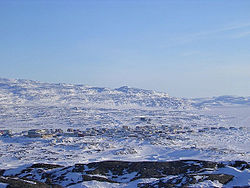Kugaaruk
|
Kugaaruk ᑰᒑᕐᔪᒃ |
|
|---|---|
| Hamlet | |

Overlooking the community
|
|
| Coordinates: 68°31′59″N 089°49′36″W / 68.53306°N 89.82667°WCoordinates: 68°31′59″N 089°49′36″W / 68.53306°N 89.82667°W | |
| Country | Canada |
| Territory | Nunavut |
| Region | Kitikmeot Region |
| Electoral district | Netsilik |
| Catholic mission | 1937 |
| Government | |
| • Mayor | Stephen Inaksajak |
| • MLA | Emilino Qirngnuq |
| Area | |
| • Total | 4.97 km2 (1.92 sq mi) |
| Elevation | 17 m (56 ft) |
| Population (2016) | |
| • Total | 933 |
| • Density | 190/km2 (490/sq mi) |
| Time zone | EST (UTC-7) |
| • Summer (DST) | MDT (UTC-6) |
| Canadian Postal code | X0B 1K0 |
| Area code(s) | 867 |
Kugaaruk (Inuktitut syllabics: ᑰᒑᕐᔪᒃKuugaarjuk or ᑰᒑᕐᕈᒃ Kuugaarruk; English: "little stream") (also called Arviligjuaq, meaning "the great bowhead whale habitat") formerly known as Pelly Bay until 3 December 1999 is located on the shore of Pelly Bay, just off the Gulf of Boothia, Simpson Peninsula, Kitikmeot, in Canada's Nunavut territory. Access is by air by the Kugaaruk Airport and by annual supply sealift. Kugaaruk means "little stream", the traditional name of the brook that flows through the hamlet.
As of the 2016 census Kugaaruk has a population of 933, a 21% increase from the 2011 census.
Near the hamlet is CAM-4, a North Warning System site that was once part of the Distant Early Warning Line.
The historical inhabitants were Arviligjuarmiut.(Bennett, 2004, chapter 26, pg. 360) Kugaaruk is a traditional "Central Inuit" community. Until 1968, the people followed a nomadic lifestyle. The population is approximately 97% Inuit and most people self-identify as Netsilik Inuit. The residents blend a land based lifestyle with modern technology and interests. Most families supplement their diet with ringed seal, caribou, and Arctic char. Other game includes narwhal, polar bear, wolverine and muskox. Despite the isolation of the community, the Inuktitut language is declining. Most people 30 and over speak Inuktitut as their first language, but the language is not being passed on to their children. In most households, a mixture of English and Inuktitut is spoken. Children understand their parents and grandparents, but respond to them in English. One goal of the Nunavut educational system is to encourage and spread the use of Inuktitut.
...
Wikipedia

